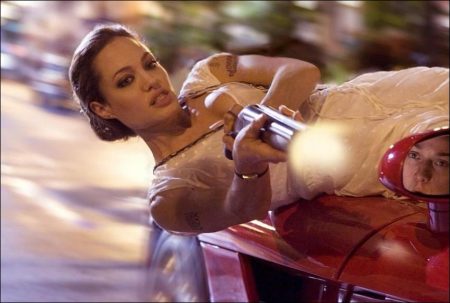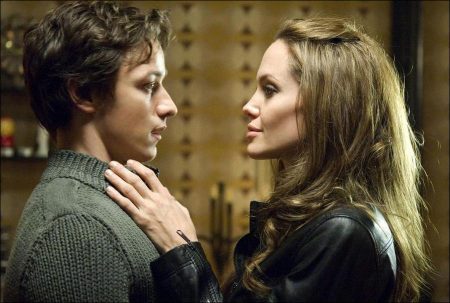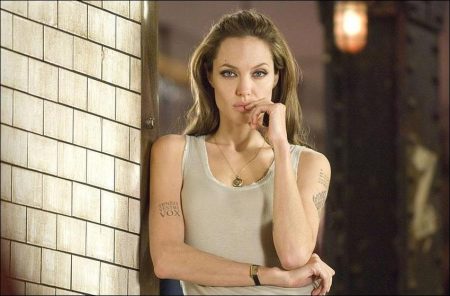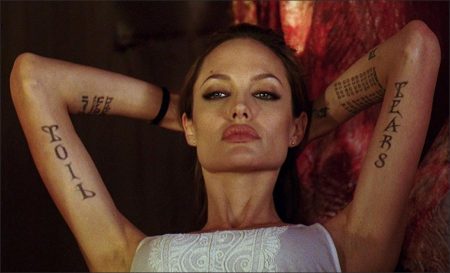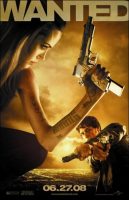Taglines: Brutal, Sexy, Built to thrill.
Wanted movie storyline. Based upon Mark Millar’s explosive graphic novel series and helmed by the stunning visualist director Timur Bekmambetov–creator of the most successful Russian film franchise in history, the “Night Watch” series–“Wanted” tells the story of one invisible drone’s transformation into a dark avenger.
25-year-old Wes (James McAvoy) was the most disaffected, cube-dwelling drone the planet had ever known. His boss chewed him out hourly, his girlfriend ignored him routinely and his life plodded on interminably. Everyone was certain this disengaged slacker would amount to nothing. There was little else for Wes to do but wile away the days and die in his slow, clock-punching rut Until he met a woman named Fox (Angelina Jolie).
After his estranged father is murdered, the deadly sexy Fox recruits Wes into the Fraternity, a secret society that trains Wes to avenge his dad’s death by unlocking his dormant powers. As she teaches him how to develop lightning-quick reflexes and phenomenal agility, Wes discovers this team lives by an ancient, unbreakable code: carry out the death orders given by fate itself.
With wickedly brilliant tutors — including the Fraternity’s enigmatic leader, Sloan (Morgan Freeman) — Wes grows to enjoy all the strength he ever wanted. But, slowly, he begins to realize there is more to his dangerous associates than meets the eye. And as he wavers between newfound heroism and vengeance, Wes will come to learn what no one could ever teach him: he alone controls his destiny.
Weaving the Design: A Brave New World
In both the comic book and the screenplay of Wanted, the characters move about in a world that, at first glance, resembles ours-but on closer look, that world is tweaked, askew, just this side of real. The characters in it don’t just move, they inhabit it in a powerful, superhuman way.
To help realize this vision, filmmakers turned to a double Oscar-winning production designer, who is quite familiar with creating an on screen version of heightened, “just this side of real” reality: John Myhre.
Myhre offers, “I was seduced by Bekmambetov in about 15 seconds-he’s just one of the most creative people I’ve ever met. It’s so fulfilling to talk to another filmmaker and have them so enthusiastic and so full of good ideas…he’d have 3,000 ideas for everything, and they’d all be great.”
Shooting in Prague
Although the film takes place in Chicago, Prague was chosen as the site of Wanted’s principal photography. Multiple reasons played into the choice. Because of the amount of filming taking place in Chicago at the time production was slated, space was tight. To make up for that shortfall, an inordinate amount of construction would have been necessary to build interiors, and this simply did not make financial sense.
Platt comments, “Although it’s been somewhat of a challenge to shoot a film like Wanted in Prague-to re-create bits of Chicago-it was the best place to film. Shooting space was plentiful, and its proximity to Moscow-where our effects were being done-was a bonus. We simultaneously shot in Prague and completed effects in Moscow. We’d shoot and cut, and then dispatch it to Russia for effects.”
Bekmambetov had worked in Prague for two years before returning to shoot Wanted, so he was exceedingly familiar with the choices of locations available-another benefit. The look of the Chicago interiors/exteriors was to be post-industrial, a mixture of steel beams, rivets, girders and basic solid architecture and brickwork, all of which needed to be combined by Myhre and his team of talented artisans into a homogenous whole.
Per locations supervisor MICHAEL SHARP: “We needed a space with a minimum of three stories to house the Loom, but we also needed to shoot as many of the interiors as possible in that one space. We ended up in an old sugar factory that was built in 1914 and closed as a plant in 1956. It had quite a neutral architecture to suit the different stages that the film goes through, but we also had the great depth and adequate space to use it as five different locations, including the magnificent Loom of Fate set. Every piece of floor in the factory was shored up and strengthened underneath, so that we could still play with two-and-a-half tons of equipment and toys to suit the sequences-without having to change the look from the top.”
Reproducing bits of Chicago in a Belle Époque sugar factory provided Myhre with a few challenges: “We did a little shifting and pulled some of the story inside, so we could be smart and economical when it came time to shoot in Chicago. Bekmambetov wanted the film to have a very American feel about it, while also embracing some European sensibilities, which shooting in Prague provided. We were able to synthesize a bit of a hybrid and take the best of all worlds, again, mixing the old with the new, a theme that runs throughout the whole of the movie.”
As Bekmambetov wished to shoot and create effects in short order, it was even more important for the art and visual effects department to stay in sync with constant communication. Visual effects producer JON FARHAT explains, “We really tapped into the talents and resources of John Myhre and we tried to let his designs drive the look for our visual effects, drive the modeling and the creation of our Fraternity, the monastery and the look of all of the interiors.”
The Loom of Fate
As mentioned, one of the most prominent sets in Wanted is the centerpiece Loom of Fate. At its heart, the Loom is a very simple structure, but the threads that it weaves determine the fate and destiny of the citizens of the world.
Bekmambetov and the screenwriters fashioned a mythology as background to the group of assassins and how they function-tapping into global mythologies that contain symbolism and imagery of weaving. In the world of Wanted, centuries before we meet Wes and the Fraternity, weavers of fabric started to decipher a code within their work, messages that spoke to the state of the world. A flaw in the fabric signaled a flaw in the world. Eventually, these flaws became the dictates to the earliest member of the Fraternity. Fate designates that someone must be killed in order for the world to carry on in a balanced way-an assassin is chosen to carry out the order of the Loom, theoretically correcting the path of the world and restoring its balance.
Fabric is woven with perpendicular threads, the weft (vertical) and the warp (horizontal, woven back and forth on a shuttle). The flaws on the Loom’s weave result from a skipped thread-these mistakes are counted and form a binary pattern, which is converted into text, and that text spells out a death order.
Production designer Myhre admits, “I always love learning something new, and the whole world of textile factories and looms was completely new to me. The way that thread is manipulated to create infinite numbers of fabrics is astounding.”
The Loom of Fate plays such a pivotal role in the movie that Myhre co-opted the theme of “weaving,” subtly incorporating it into the overall design: “The idea is that everything is woven together from the very beginning. Wesley’s office is one of those horrible places comprised of lots of little cubicles with woven fabric on the walls. Outside the Fraternity the telephone lines are crisscrossed, like tumbles of spiderwebs. It’s all the way through the film, just in a very unobtrusive way.”
Platt comments, “In the Old Testament, there is a whole system of numerology where words are prescribed numbers and those numbers represent a code. In many ways, the mythology created for this film is no different.”
Production took inspiration from the more than 100 different textile factories within a two-hour ride from the center of Prague. Field trips were taken to view the looms and study how fabric is manufactured. Looks from different plants were combined and reproduced, and the Loom of Fate is a final amalgam of several of these plants’ looms.
The physical Loom itself was assembled together from rentals and newly constructed pieces, and the combination of black metal, worn wood and spare brass fittings ends up resembling a machine from the turn of the 20th century (appropriate, as the Fraternity’s current headquarters is said to have been built in Chicago at that time). In keeping with the film’s subtle and overall mix of old and new, the art department also added some offbeat, modern touches, such as magnifying glasses around the edges of the Loom to refract light to the tables underneath.
More looms, but on a lesser scale, were incorporated into the design of the Fraternity’s shop floor (in addition to being the group’s headquarters, it is also a producing textile mill). Myhre comments, “The shop floor looms are partially threaded from the ceiling overhead, and they form these huge fantastic shapes-when you put a couple of them together, you start getting a very Gothic-looking arch. It gives the feel of an old church or a castle, and this castle feel is evident in the Chicago Fraternity. The building is fronted by two enormous wooden gates; to enter, you have to drive over a bridge over a small moat.”
Continue Reading and View the Theatrical Trailer
Wanted (2008)
Directed by: Timur Bekmambetov
Starring: James McAvoy, Morgan Freeman, Angelina Jolie, Common, Kristen Hager, Konstantin Khabensky, Sophiya Haque, Lorna Scott, Chris Pratt, David O’Hara, Marc Warren
Screenplay by: Michael Brandt, Derek Haas, Chris Morgan
Production Design by: John Myhre
Cinematography by: Mitchell Amundsen
Film Editing by: David Brenner
Costume Design by: Varvara Avdyushko
Set Decoration by: Richard Roberts
Art Direction by: David Baxa, Patrick M. Sullivan Jr., Martin Vackár, Tomas Voth
Music by: Danny Elfman
MPAA Rating: R for strong bloody violence throughout, pervasive language and some sexuality.
Distributed by: Universal Pictures
Release Date: June 27, 2008
Views: 97
